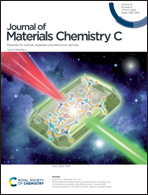An enantiomeric pair of 2D organic–inorganic hybrid perovskites with circularly polarized luminescence and photoelectric effects†
Abstract
Chiral two-dimensional (2D) organic–inorganic hybrid perovskites (OIHPs) attract increasing interest due to their potential applications in spintronic and optoelectronic devices. However, the circularly polarized luminescence (CPL) properties of chiral 2D OIHPs remain largely underdeveloped because of (i) the lack of an efficient design strategy of chiral 2D OIHPs and (ii) the poor room-temperature emission of most 2D OIHPs. We synthesized a new enantiomeric pair of single crystals of OIHPs, (R)-C6H16N2PbBr4 (R-1) and (S)-C6H16N2PbBr4 (S-1), using chiral R/S-cyclohexanediamine (R/S-CHD) cations and racemic single crystals of rac-(C6H16N2)2Pb2Br8·H2O (rac-1) using rac-cyclohexanediamine (rac-CHD) cations. R/S-1 and rac-1 demonstrated different temperature-dependent emissions from self-trapping excitons (STEs) because of the distinct octahedral coordination modes of Pb2+ ions. The chirality of the inorganic emitting layer of (PbBr6)n in R/S-1 is inherited from interlayer chiral CHD, showing interesting mirror-image CPL at room temperature, while rac-1 is CPL silent. More interestingly, the photoelectric effect of R/S-1 crystals is superior to that of rac-1, indicating that chiral polarization is more prominent in chiral 2D OIHPs. This work provides a new platform to study the chirality-related optical properties in OIHPs at an atomically precise level.



 Please wait while we load your content...
Please wait while we load your content...